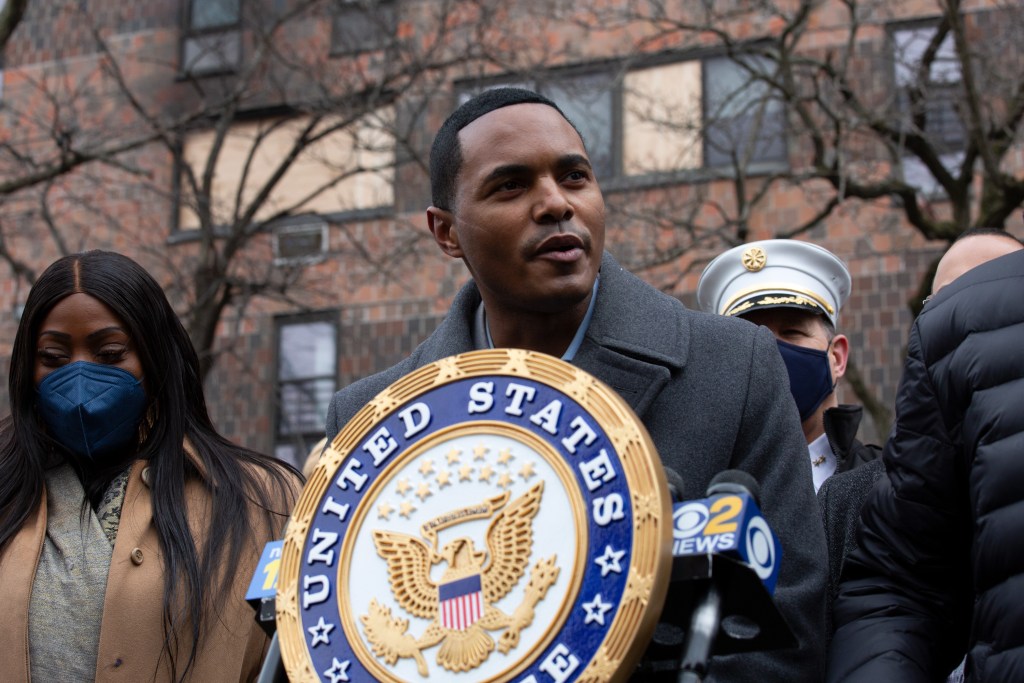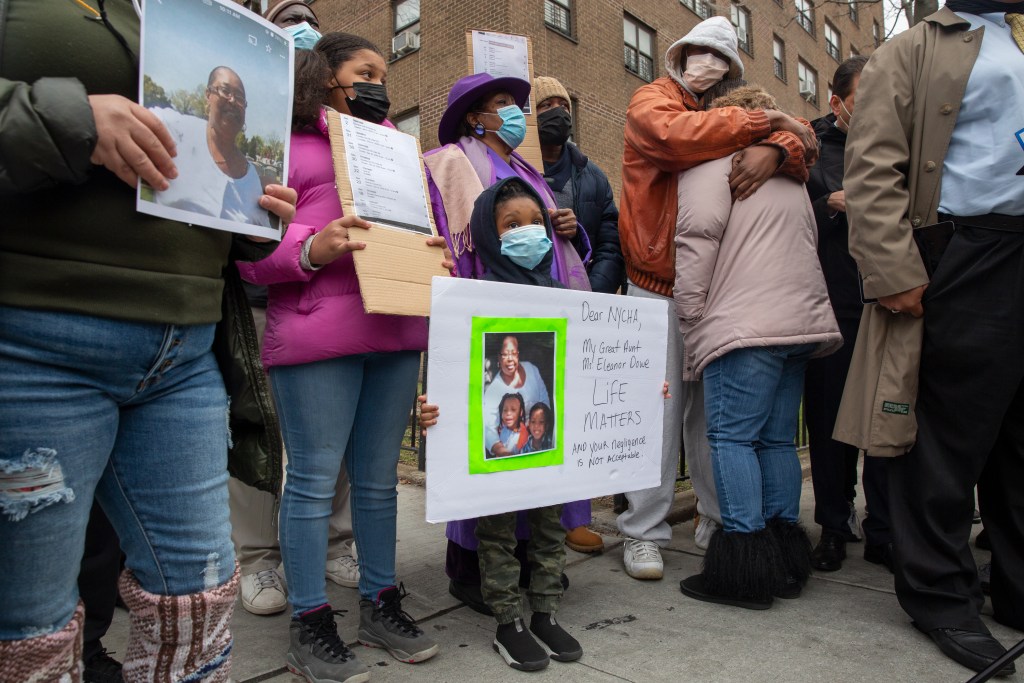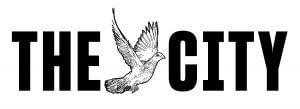Five Years Later, Still ‘A Long Way to Go’ on NYCHA Agreement With Feds
Meaningful change on mold, elevators, and lead paint remains elusive years after a surprise de Blasio-Trump agreement to install an independent monitor to oversee public housing repairs.

Housing Secretary Ben Carson and Mayor Bill de Blasio sign a deal to have a new federal monitor oversee NYCHA, January 31, 2019. Photo by Ben Fractenberg/THE CITY
This article was originally published on by THE CITY
Five years ago this week, the nation’s biggest public housing authority signed an unprecedented agreement committing itself to fix decades of mismanagement and neglect that had forced thousands of residents to endure squalid conditions for years.
The deal raised eyebrows at the time, and not just because former Mayor Bill de Blasio and Trump administration Department of Housing and Urban Development Secretary Ben Carson announced it at a joint event in Lower Manhattan.
The federal government had sued the New York City Housing Authority after investigators determined city officials had lied for years about lead paint and other hazards — then suddenly agreed to settle out of court after a judge had deemed their proposed deal toothless.
That didn’t stop Carson and de Blasio. Under their January 31, 2019 pact, the New York City Housing Authority agreed on deadlines to clear apartments in its 320 developments of lead paint and toxic mold, upgrade failing elevators and heating systems, and greatly reduce vermin infestation.
An independent monitor was part of the deal, to help ensure Housing Authority management kept its promises to keep apartments livable.
When the anniversary arrived Wednesday, NYCHA could have exercised its option, written into the agreement, to ask federal overseers to terminate the monitor’s oversight and exit the arrangement at the five-year mark.
That did not happen.
To end the oversight, NYCHA would have had to demonstrate to HUD and the Manhattan U.S. attorney that they’d been in significant compliance with the terms of the original agreement for the last year. And while it has seen some successes, much of what it promised back in 2019 is nowhere near complete.
Some observers contend the agreement has been a failure and did not engineer a substantive transformation of NYCHA’s culture of failure. Some suggest it has created a lasting foundation for real change, but that much work needs to be done going forward.
And whether it was a success or a failure, it’s unlikely the arrangement will be changing anytime soon.
A new monitor starts next month after the initial five-year contract expired. Meanwhile, NYCHA’s current CEO, Lisa Bova-Hiatt, embraces the oversight of a monitor and the continued helicopter parenting by HUD and federal prosecutors with the Southern District of New York — a contrast to her predecessor, Gregory Russ.
“I see a benefit of having a monitor and having this close collaboration with HUD and Southern District,” Bova-Hiatt told THE CITY. “I believe that the HUD agreement really gave us the opportunity to look systematically at all of our pillar areas and most importantly, look at the way we were being managed. I don’t think it’s a bad thing. We’ve made fundamental changes to our management and we’ve established best practices.”
But, she adds, “Quite frankly, we have a long way to go.”
“A $70 million drain”
During those five years, HUD and the U.S. Department of Justice never exercised an enforcement option baked into the agreement in which they could have gone to court to force NYCHA to come into compliance. Neither responded to THE CITY’s request for an explanation about their decisions.
The monitor also had an option to ratchet up the pressure by issuing “remedial directives” ordering NYCHA to take specific action if he determined NYCHA was in substantial noncompliance with any aspect of the agreement.
That also never happened. The monitor, Bart Schwartz, also declined to discuss this.
Five years in, this reluctance to crank up the pressure echoes a prediction made by the federal judge who declined to sign off on a proposed Carson-de Blasio deal: that the pact was too vague to enforce.
In 2018 then-Manhattan U.S. Attorney Geoffrey Berman announced the findings of an investigation by his office documenting how for years NYCHA managers had deliberately lied to federal housing officials, falsely certifying they’d properly inspected and remediated lead paint in their aging properties. NYCHA management also erroneously insisted that the vast majority of the authority’s 175,000 apartments were lead free. In fact, more than 50 percent contained lead paint, a potentially dangerous substance that causes cognitive damage in young children who ingest it.
Berman’s team also revealed how NYCHA managers regularly gamed HUD inspectors by hiding unsafe and unhealthy building conditions during inspections. All of this deliberate deception went undetected by HUD for years and reinforced the need for consistent, on-the-ground oversight.
Threatened with a civil lawsuit by the U.S. attorney, NYCHA agreed to sign a consent decree with the feds, requiring that city housing officials fix the lead and other living condition issues under the watchful eye of a federal judge.
But the decree lacked any real timeline or set goals, and then-U.S. District Judge William Pauley, who was assigned the case, shot it down as too vague and lacking real enforcement tools.
“The concerns over vague enforcement mechanisms are fully animated in this case,” Pauley wrote. “They offer scant precision on the provisions or obligations (to the extent that they are defined) that are enforceable, the types of violations that may be enforced or the mechanisms by which non-compliance with the [decree] may be addressed.”
In response, Berman and Carson decided to withdraw the decree and craft a new agreement that took the judge out of the picture. NYCHA and de Blasio signed on.
U.S. Representative Ritchie Torres (D-The Bronx), who grew up in a Bronx NYCHA development and chaired the public housing committee when he was in the City Council, believes signing an agreement out of court was a big mistake.

“I originally had high hopes for this, but Pauley’s skepticism has been vindicated,” Torres told THE CITY. “I’m critical. I’ve grown increasingly skeptical of the federal monitorship. I see the federal monitor as a $70 million drain on NYCHA with next to nothing to show for it. No one can seriously claim there’s been a substantive transformation of NYCHA’s management.”
Torres favors judicial oversight, referencing another consent decree NYCHA signed known as the Baez agreement that forced them to aggressively eradicate toxic mold from apartments, a problem that is of specific concern to tenants with respiratory ailments.
“I think for a federal monitorship to be maximally effective, there should be judicial oversight,” Torres said. “Judicial oversight is an essential ingredient.”
U.S. Representative Nydia Velazquez (D-Queens/Brooklyn), whose longtime advocacy for increased federal funding for public housing has been stymied by the Republican leadership of the House, also criticized the monitor for what she felt was poor communication.
“I believe there has been a lack of interaction and transparency from the monitor’s office regarding their enforcement work and how they used the authority granted to them under the decree,” she said.
Aixa Torres, the Manhattan representative of the tenant leadership group Citywide Council of Presidents and a Smith Houses resident, once had high hopes for the 2019 HUD agreement, but now says she struggles to see what has fundamentally changed.
“At the end of five years I don’t need reports to tell me how things are. I need action,” she said, nevertheless praising what she felt was a sincere effort by the current monitor to try and make things better. She now worries that the new monitor, the law firm of Jenner & Block, won’t be able to turn the ship around in any meaningful way once it takes over next month. (A spokesperson for Jenner & Block declined to answer THE CITY’s questions about its plans.)
“I’m exhausted,” she said. “Resident leaders are asking what are you going to do? What happens now?”
Repair delays
Under Schwartz and his firm, Guidepost Solutions, the monitor employed field teams that inspected developments daily, performing random checks but also responding to specific tenant issues. He also put a new focus on data, including creating software to photograph and document conditions via an app, and new analysis of the repair histories of elevators and boilers to better manage upkeep.
The task of reforming NYCHA within five years proved impossible, in part due to the Covid pandemic pausing the timeline of much of what NYCHA vowed to accomplish and altering the financial landscape. Thousands of tenants stopped paying their rent, racking up what is now $424 million in rent arrears by over 71,000 households.
NYCHA’s rent collection rate — which had held steady between 90 percent and 95 percent pre-pandemic — now tracks around 62 percent.

Much of the hoped-for progress of the 2019 agreement remains aspirational, authority stats show.
The average number of days it takes NYCHA to complete apartment repairs now stands at more than a year — 377 days, up from 334 in December 2022. And none of the construction trades — carpenters, plumbers, electricians, masonry workers — are currently meeting time goals for completing repairs. The average time to complete a paint job in apartments rose from 423 days in 2022 to 460 last year.
Meanwhile, the number of vacant apartments peaked at more than 4,800 in December, up from 3,100 a year ago, in part due to a longer turnaround time required when a tenant moves out that results from apartment fix-ups mandated by the agreement.
Much of the most visible improvement that has taken place is organizational. The top positions of CEO and chair — once held by a single appointee — have been split into two roles, with the chair now serving as a volunteer. And the formation of new quality assurance and compliance units has improved the agency’s ability to make its reform efforts more efficient.
On the long perplexing problem of mold buildup in bathrooms, in June NYCHA reported that the rate of new tenant repair requests for mold and water leaks per month had dropped from an average of 2,400 per month in 2019 to 1,200 per month last year. The dip has been consistent for four years, with the total number of complaints falling from 17,136 in 2020 to 9,411 last year.
This is in part due to the continuing judicial oversight in a federal lawsuit known as Baez that targets mold, but also to NYCHA’s success in replacing hundreds of non-functioning roof fans to improve air circulation and reduce moisture building up bathrooms and kitchens. In the past, NYCHA would perform quick fixes and the mold soon returned. Now repair teams are better organized and target underlying issues so mold does not recur in the same unit within a 12 month period 85 percent of the time — a goal set by the agreement that NYCHA has met.
At the same time, however, the backlog of older mold and leak repair requests had rocketed from 35,000 in October 2019 to more than 90,500 in April 2023. It has since fallen somewhat to more than 77,000 open requests as of last week.
Rampaging rats
The agreement also exposed the true scope of NYCHA’s dysfunction on the question of how much lead paint lingered in its aging portfolio of 175,000 apartments.
For years, NYCHA insisted only a small number of apartments contained the potentially hazardous paint. But after the media raised questions about this, de Blasio ordered more than 120,000 units to be retested.
Following the HUD agreement’s protocols, NYCHA has to date retested 104,000 units, of which more than 25,000 — including thousands the authority had previously declared “lead free” — tested positive for lead. Pushed by the monitor, NYCHA is now averaging 4,800 lead abatements per year — far above the 700 completed in all of 2019.
They’ve not done as well with the HUD agreement’s requirements regarding the Harlem River Houses in Manhattan and Williamsburg Houses in Brooklyn — two particularly lead-prone developments they were supposed to completely clean of lead within five years. As of this week, they were just over halfway to the goal line at both.
And the authority has struggled in vain to meet the agreement’s requirements to confront and address the chronic outages that plague many of its 3,163 passenger elevators.
NYCHA, for instance, vowed that by the five-year deadline, in at least 85 percent of buildings with one or more elevators there would be no more than one instance where all the elevators are out of service — events that strand seniors and wheelchair users for hours. While the number of these incidents has dropped, it’s still high, with nearly 14,000 last year.

NYCHA committed to replacing 425 elevators by the end of this year, but as of last week, 243 had been replaced. A spokesperson said they now hope to make the promised goal by mid 2025.
Of the 133 boilers NYCHA promised to replace by the five-year deadline, the authority has replaced 98, with another 207 in the pipeline. Under an ongoing effort to turn over buildings to private managers via a federal program known as Rental Assistance Demonstration (RAD), NYCHA is ahead of the game, with 263 boilers replaced — far above the 200 they’d promised in the HUD deal.
As for rats, NYCHA made an unusual promise in the HUD agreement: a vow to achieve a “50 percent reduction of rat population” within three years, with another 50 percent by the five-year goal line. Not surprisingly, no such achievement occurred, primarily because no one could really define the actual size of the “rat population” that lives within the public housing developments of New York.
Michael Horgan, a spokesperson for NYCHA, told THE CITY the agency is working with the monitor, HUD and the U.S. Attorney’s Office to “determine a pest population index that could be used to track populations over time.” They noted that “various third-party academic experts” have raised concerns about any statistical analysis of this rather hard-to-define metric.
The spokesperson did note that the number of “verified rat complaints” has dropped from a high of 4,890 in 2021 to 3,051 last year.
HUD Secretary Marcia Fudge declined THE CITY’s request to discuss the ups and downs of the 2019 agreement, but a spokesperson, Olga Alvarez, called the pact “a starting point,” asserting, “Based on NYCHA’s estimate of almost $80 billion of capital repairs, NYCHA has much work to do to improve the living conditions of its residents. However, it is undeniable that much work has been done in the past five years to improve housing conditions.”
Velazquez, who continues to push her bill allocating $70 billion in federal funding for public housing nationwide, also gave the 2019 agreement mixed grades, stating, “NYCHA has made some progress since the decree was implemented, but there is still so much work to be done. I expect the agreement to remain in place for the foreseeable future and to continue to work with NYCHA and the new monitor to ensure the agency is advancing toward the goals of the decree.”
NYCHA CEO Bova-Hiatt notes another, less obvious benefit of the agreement — increased transparency. Since 2019, the authority has made much of its data — warts and all — available to the public in a more accessible setting.
“I think transparency holds people accountable. My feeling is, the more transparent we are the better. Which is why our relationship with HUD, with Southern District and with the monitor has gotten better.”
“I, as the CEO, want to be transparent,” she added. “I don’t want to hide anything.”
THE CITY is a nonprofit newsroom that serves the people of New York. Sign up for our SCOOP newsletter and get exclusive stories, helpful tips, a guide to low-cost events, and everything you need to know to be a well-informed New Yorker.
Related Stories
- Stabbing Victim at Farragut Houses Sues NYCHA for Negligence
- Repair Estimate for NYCHA Grows to Over $78 Billion
- Fearing Displacement, Coney Island NYCHA Tenants Protest Privatization Plan
Email tips@brownstoner.com with further comments, questions or tips. Follow Brownstoner on Twitter and Instagram, and like us on Facebook.










What's Your Take? Leave a Comment